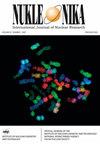Ablation of single-crystalline cesium iodide by extreme ultraviolet capillary-discharge laser
IF 0.7
4区 物理与天体物理
Q4 CHEMISTRY, INORGANIC & NUCLEAR
引用次数: 0
Abstract
Abstract Extreme ultraviolet (XUV) capillary-discharge lasers (CDLs) are a suitable source for the efficient, clean ablation of ionic crystals, which are obviously difficult to ablate with conventional, long-wavelength lasers. In the present study, a single crystal of cesium iodide (CsI) was irradiated by multiple, focused 1.5-ns pulses of 46.9-nm radiation delivered from a compact XUV-CDL device operated at either 2-Hz or 3-Hz repetition rates. The ablation rates were determined from the depth of the craters produced by the accumulation of laser pulses. Langmuir probes were used to diagnose the plasma plume produced by the focused XUV-CDL beam. Both the electron density and electron temperature were sufficiently high to confirm that ablation was the key process in the observed CsI removal. Moreover, a CsI thin film on MgO substrate was prepared by XUV pulsed laser deposition; a fraction of the film was detected by X-ray photoelectron spectroscopy.极紫外毛细管放电激光烧蚀单晶碘化铯
摘要极紫外(XUV)毛细管放电激光器(CDL)是一种有效、清洁烧蚀离子晶体的合适光源,而传统的长波长激光器显然难以烧蚀离子晶体。在本研究中,碘化铯(CsI)单晶受到以2Hz或3Hz重复频率运行的紧凑型XUV-CDL装置发出的46.9nm辐射的多个聚焦1.5-ns脉冲的照射。烧蚀速率由激光脉冲积累产生的凹坑深度确定。用Langmuir探针对聚焦XUV-CDL束产生的等离子体羽流进行了诊断。电子密度和电子温度都足够高,以证实烧蚀是观察到的CsI去除的关键过程。此外,采用XUV脉冲激光沉积方法在MgO衬底上制备了CsI薄膜;通过X射线光电子能谱检测膜的一部分。
本文章由计算机程序翻译,如有差异,请以英文原文为准。
求助全文
约1分钟内获得全文
求助全文
来源期刊

Nukleonika
物理-无机化学与核化学
CiteScore
2.00
自引率
0.00%
发文量
5
审稿时长
4-8 weeks
期刊介绍:
"Nukleonika" is an international peer-reviewed, scientific journal publishing original top quality papers on fundamental, experimental, applied and theoretical aspects of nuclear sciences.
The fields of research include:
radiochemistry, radiation measurements, application of radionuclides in various branches of science and technology, chemistry of f-block elements, radiation chemistry, radiation physics, activation analysis, nuclear medicine, radiobiology, radiation safety, nuclear industrial electronics, environmental protection, radioactive wastes, nuclear technologies in material and process engineering, radioisotope diagnostic methods of engineering objects, nuclear physics, nuclear reactors and nuclear power, reactor physics, nuclear safety, fuel cycle, reactor calculations, nuclear chemical engineering, nuclear fusion, plasma physics etc.
 求助内容:
求助内容: 应助结果提醒方式:
应助结果提醒方式:


